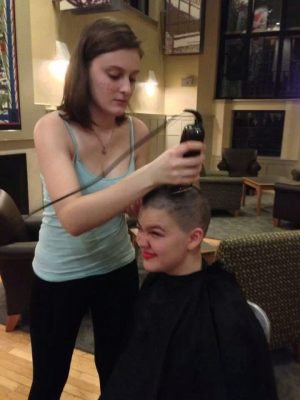What you need to know to be a true Mawrtyr.
By Chloe Vilkin
Bryn Mawr College is known for its major traditions, but the everyday traditions are just as important. Learning the campus lingo can be confusing as a new student. Here is a lexicon of helpful words to know to become a true Mawrtyr.
Bra tree [brah][tree] noun
- a Weeping Hemlock located outside of Rockefeller dorm. This tree is often found with a bra or two strewn about its branches.
The scent of pot can be smelled wafting around the walkway next to this tree most days, as it is visited daily by students who wish to smoke marijuana cigarettes under the privacy of its floor-length tangle of branches. At some point, probably years ago, students maneuvered a wooden bench between the branches of the tree so they could sit comfortably while smoking:
“I heard a few underclassmen outside of the canopy ask each other if they thought it smelled like weed, and I looked over to my friend and whispered, “Don’t they know they are right by Bra tree?”
Bryn Mawr Chop [brin][mahr][chop] noun
- a dramatic haircut often gotten at some point during a student’s time at Bryn Mawr College. The haircut stereotypically involves one “chopping” their hair from a long

A Bryn Mawr student getting her chop
length to a collarbone-or-shorter length. This change often—but definitely not always—coincides with some sort of shift in the student’s gender identity or pronouns. This haircut is not necessarily a one-time-only experience:
“I saw that Meagan had shaved her head before the school year began when I walked in to the first journalism class of the year. The year before she cut her long locks into a short bob, and the year before that she shaved one side of her head. I asked how she would continue her yearly tradition of the Bryn Mawr Chop if she had already shaved her head, but she did not have an answer.”
- see also: post-breakup haircut
Cancel culture [kan-suhl][kuhl-cher] noun
- the general ease with which people are “cancelled” for because of statements or actions made that go against the unspoken norms of the political, social, and philosophical beliefs of the student body and faculty. The cancel culture at Bryn
 Mawr is substantial, despite the fact that the norms shift with time. Students seem always ready and willing to call each other out for doing or saying “problematic” things; the issue with this sort of culture is that students are so ready to “cancel” other people they often do not give them a chance to correct their behavior or change their point of view:
Mawr is substantial, despite the fact that the norms shift with time. Students seem always ready and willing to call each other out for doing or saying “problematic” things; the issue with this sort of culture is that students are so ready to “cancel” other people they often do not give them a chance to correct their behavior or change their point of view:
“I told my friend that I like to watch Jeffree Star’s YouTube videos and she asked me if I did it ironically, because he is cancelled.“
“In my head I thought: “Well, he apologized for using a slur, which was like 10 years ago, and he has changed his behavior since then, and this is why I hate cancel culture because people are not allowed to move on after they make a mistake.”
Out loud I just said, “no.”
Chamber of Secrets [cheym-ber][uhv, ov][see-krits] noun
- a small, unlit room within the depths of Old Library. This room sits at the very end of the odd tunnels in the basement of Old Library, formerly known as Thomas Hall. It is located next to a door that leads from the tunnels to the lobby area of the graduate student lounge.
The Chamber has been blocked off with a chain link door and a padlock since 2015, although this has not stopped students from maintaining the tradition of writing their names in the Chamber. Instead of writing on the walls and across the pipes that run along the low-hanging ceiling inside the Chamber, students scroll their Sharpies along the edges of the door and the eggshell-colored walls:
“It was 2016 and I was a first-year contemplating what incredible thought to write outside the Chamber of Secrets as part of the first night of Hell Week. “Fuck the Patriarchy,” I said out loud as I uncapped my pen.”

 By Yi Gao
By Yi Gao 


